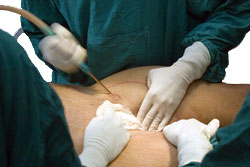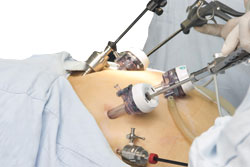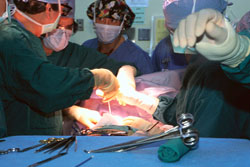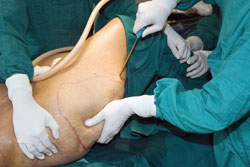- Weight loss surgery: A possible treatment for obesity?
- Other treatments for obesity
- Surgery for weight loss guidelines
- Weight loss surgery and children
- Methods for weight loss surgery
- Preparing for weight loss surgery
- Types of weight loss surgery
- Conclusion
Introduction to surgery for weight loss
Obesity has now become a worldwide epidemic with approximately one quarter of the world’s population fitting the classification of obese. Rates of obesity are also continuing to rise as more people adopt sedentary lifestyles (characterised by little exercise and poor diet). Obesity should be considered a serious disease because it can lead to several medical problems including heart disease, diabetes and high blood pressure. It is essential that appropriate treatment is sought to prevent unnecessary morbidity and mortality.

Surgery is often considered a last resort for patients with severe obesity with associated medical problems where other interventions have failed. Numerous surgical techniques have been used to treat obesity which change in popularity over time and in different countries. The procedures differ in their abilities to produce weight loss and their side effects and risks. It is important that you discuss these factors with your doctor.
The most common procedures for weight loss include:
- Gastric bypass: This involves connecting part of the stomach to the small intestine so that a section of small intestine is bypassed. The small intestine is normally responsible for the absorption of most nutrients and fats. (Please refer to anatomy and physiology of the gastrointestinal system for further information).
- Gastroplasty or gastric stapling: Changing the size of the stomach reservoir by stapling it into a small pouch segment. This reduces how much food it can hold.
- Gastric banding: Placing a belt around the stomach to reduce its capacity to hold food.
Each of the surgical techniques produces weight loss by either a restrictive mechanism (reducing the capacity of the stomach and reducing food intake) or a mal-absorptive mechanism (reducing absorption of nutrients and calories by bypassing segments of small intestine).
You should remember that surgery does not always cure your disease. You need to make strict lifestyle and diet changes to maintain your weight loss. Weight gain is a late complication of many of the surgical techniques. Your doctor will also offer other treatments such as diet and support groups to treat your obesity.
Weight loss surgery: A possible treatment for obesity?

Obesity is specifically defined as a body mass index (BMI) greater than 30. Today approximately 15-30% of the Australian population is considered obese. (Please refer to the article on obesity under statistics for further information).
Obesity can contribute to several health problems including heart disease, diabetes, high blood pressure, elevated cholesterol, arthritis and liver disease. This emphasises the importance of appropriate treatments to combat the condition.
Other treatments for obesity

The number of weight loss surgeries performed has quadrupled in recent years. The aim of treatment is to attain normal body weight without causing significant complications.
Traditional methods for weight loss include reducing the number of calories in the diet (click here to learn about the role of your metabolism and dieting), increased physical activity, and behaviour therapy. However, obesity is often difficult to treat with diet and exercise alone.
Surgical treatments tend to be reserved for patients with morbid obesity (defined as a BMI greater than 40) that can’t lose weight by the traditional means. Careful selection of patients is important as the surgery itself is associated with significant risks and is not always successful. However in severely obese patients the benefits to mental health, physical health and appearance, usually outweigh the risks of the surgery. A variety of surgical procedures have been used which are described in more detail below.
Surgery for weight loss guidelines
There are a number of guidelines which are considered when deciding whether you are suitable for weight loss surgery as follows:
- Are you aged 18 years or older? There is limited experience of surgery in children and adolescents.
- Is your weight greater than 45kg above your ideal body weight?
- Is your BMI greater than 40? Sometimes surgery may be performed in patients with lesser degrees of obesity if they have other associated medical problems.
- Have you tried other therapies and made reasonable attempts at weight loss? Your doctor will need to see that you have made positive lifestyle changes to lose weight and that you are sufficiently motivated.
- Will you be able to tolerate surgery? Your doctor will need to make sure you have no specific medical or psychological conditions that make surgery or anaesthetics unsafe.
- Will you be committed to long term follow up?
Weight loss surgery and children

Methods for weight loss surgery
Surgical techniques to treat obesity can be broadly classified into restrictive and mal-absorptive procedures. The former includes procedures such as gastric banding which physically limit the amount of food that can be consumed by reducing the size or capacity of the stomach reservoir. Mal-absorptive procedures typically involve bypassing a segment of small intestine to reduce the absorption of calories and hence lead to weight loss. Both methods produce good results in terms of weight loss. Surgery may cause you to lose 50-70% of the excess weight you are carrying. However, bypass operations are associated with more early complications and can cause malabsorption of essential nutrients and minerals as they try to limit your calorie intake.
Preparing for weight loss surgery
Before you are considered for surgery, your doctor will undergo several assessments of your weight and associated medical problems. It is likely that you would have tried several other treatments before surgery is considered. Your doctor will need evidence that you are motivated and have adhered to previous treatment programs. This is important as following some surgeries you are required to follow strict diets to prevent side effects. If you cannot show this motivation and discipline pre-operatively it is unlikely that it will continue post-operatively.
Some programs may have a set amount of weight loss that needs to be achieved prior to surgery. Prior to your surgery, the doctor will describe in detail the proposed operation and possible complications. You should have a realistic understanding of the risks and lifestyle changes that will be necessary afterward.

You should quit smoking at least 6 weeks prior to operation to decrease your risk of lung complications. Additional measures may be needed to reduce your risks of wound infection, aspiration due to reflux, airway problems and hernia formation.
The following factors are essential after the operation:
- Healthy diet: depending on the type of surgery you may need to make specific dietary changes such as reducing meal sizes.
- Regular exercise.
- Support groups.
- Regular follow-up with the surgeon.
By applying these new habits and following your doctor’s advice you can decrease your risk of serious conditions, improve your social outlook, and restore your self-esteem. Specific surgical treatments for obesity are described in more detail below.
Types of weight loss surgery
Wiring jaws
Jaw wiring is an uncommon procedure for weight loss today and was mainly in the seventies and eighties. It involves wiring the jaws closed to prevent the consumption of solid food. Your diet may therefore be restricted to liquid feeds. Jaw wiring is only a temporary measure and does not help you learn new dietary and behavioural habits. It has poor success rates as many patients will regain weight once the wires are removed. Occasionally jaw wiring may be used in conjunction with a tight nylon waist cord which reduces weight gain.
Gastroplasty

Benefits
Gastroplasty is generally a quick and safe procedure to perform. It produces good weight loss results. Deficiency of vitamins or iron deficiency are rare as absorption is not affected. Osteoporosis is also less common than with bypass procedures.
Risks and side effects
Failure to comply with your required eating habits post-operatively can lead to vomiting. As your stomach has been made smaller, it needs smaller sized meals. Weight gain can also occur if you choose to eat high caloric soft foods such as ice-cream and soft drinks, which can easily pass through the stoma. Gastroplasty is quite a major surgery that can lead to scarring and infection. It cannot be adjusted or reversed like some of the other surgical options. In rare cases the staples can breakdown and the procedure no longer works.
Click here for more information
Gastric banding
Gastric banding was first performed in 1993 and is now a common procedure performed for weight loss in Australia and Europe. Approximately 180,000 cases have now been performed worldwide. Gastric banding can be performed laparoscopically (via key-hole surgery) which reduces the need for a large incision. A silicone band is placed around the upper part of the stomach. Like gastroplasty, this divides the stomach into a small pouch and larger segment. The small pouch reduces the capacity of the stomach which causes a reduction in meal sizes. This eventually leads to weight loss and patients learn long-term healthy eating patterns.
Benefits
Gastric banding is a quick, safe and minimally traumatic procedure with the shortest recovery time. You usually will need to be in hospital for less than 24 hours. Gastric banding can lead to substantial weight loss. The average weight loss is 43kg (32 percent of body mass). The biggest advantage of gastric banding is it is adjustable. The silicone band is fitted with a balloon that can be blown up with fluid or deflated (via an access port under the skin) to change how tight the band is on the stomach. Thus as your circumstances change, the procedure can easily be changed without need for more invasive surgery. For pregnant women for example, the stomach outlet size can be increased to cater for greater metabolic and nutritional demands. The procedure can also be simply and safely reversed if required.
Risks and side effects
Again there is a risk of vomiting after gastric banding if you do not adjust your meal sizes appropriately and overload the stomach. In addition, the procedure is not suitable for all patients and some can adopt techniques that maintain a heavy caloric diet (such as drinking high calorie beverages). In terms of operative risks, gastric banding is considered safe with fewer complications compared to other techniques. The risk of mortality from the procedure is close to zero percent.
Bypass
Jejunoileal bypass was the first surgical weight loss technique performed in 1954. For this procedure a section of upper small intestine was connected to distal small intestine, thus bypassing a significant section of small intestine. This interfered with absorption and lead to significant weight loss. However, this technique is no longer performed as it was found to cause serious complications including malnutrition and cirrhosis of the liver. Gastric bypass procedures were introduced later in 1967.

Biliopancreatic diversion or bypass is a variation of gastric bypass surgery. This involves the creation of a larger gastric pouch and removal of the lower portion of the stomach. The pouch is connected directly to a section of the small intestine. The remaining proximal section of the small intestine is later connected and this provides the bile and pancreas juices. This procedure is performed less commonly than banding and gastric bypass as it has significant complication rates and leads to malnutrition.
Benefits
Gastric bypass probably produces the best weight loss results with patients losing up to 50-70% of their excess weight at 10 years. Long term maintenance of weight loss is usually achieved.
Risks and side effects
Gastric bypass is a major operation associated with significant risks of complications such as infections, perforation, leakage of stomach juices and abdominal hernias. The risk of death is higher than other procedures as it is a larger surgery. Furthermore the procedure is more expensive than other options. Bypass operations can cause lots of long term complications so it is essential that you continue to see your doctor for surveillance. Poor absorption of fats and other nutrients can lead to flatulence, iron deficiency, vitamin B12 deficiency, calcium deficiency, osteoporosis and malnutrition. You will be required to take vitamin and mineral supplements to help prevent this from occurring.
Liposuction

Conclusion
Whilst surgery is becoming increasingly common for the treatment of obesity, diet, exercise and long-term lifestyle changes remain the cornerstone of treatment. Surgery should generally be a last resort for the very obese patient where other treatments have failed. In the morbidly obese patient surgery is the most cost effective treatment, producing greater long term weight reduction than behavioral or drug therapies. However surgery needs to be part of an integrated treatment plan to achieve long term weight reductions. In addition, surgery should only be considered after recognition of the potential operative and long-term complications.
More information
 |
For more information on obesity, health and social issues, and methods of weight loss, as well as some useful tools, see Weight Loss. |
References
- Copp J. Lapband Surgery [online]. Obesity Surgery Lapband Surgery Queensland Australia, [cited April 2007]. Available from: URL link
- Flier J, Maratos-Flier E. Obesity. In Kasper et al (eds). Harrison’s Principle of Internal Medicine (16th edition). New York: McGraw-Hill; 2006. [Book]
- Glenny A, O’Meara S, Melville A, Sheldon T, Wilson C. The treatment and prevention of obesity: A systematic review of the literature. Int J Obes Relat Metab Disord. 1997;21(9):715-737. [Abstract]
- Grace M. Surgery for obesity. In Morris P, Wood W. (eds). Oxford Textbook of Surgery, (2nd edition), Oxford: Oxford University Press; 2000. [Book]
- Kumar P, Clark M (eds). Clinical Medicine (5th edition). Edinburgh: WB Saunders Company; 2002. [Book]
- Maggard M, Shugarman L, Suttorp M, et al. Meta-analysis: surgical treatment of obesity. Ann Intern Med. 2005;142(7):547-59. [Abstract]
- Noel P, Pugh J. Management of overweight and obese adults. BMJ 2002;325:757-761. [Abstract | Full text]
- Snow V, Barry P, Fitterman N, Qaseem A, Weiss K. Pharmacologic and surgical management of obesity in primary care: a clinical practice guideline from the American College of Physicians. Ann Intern Med. 2005;142(7):525-531. [Abstract]
- Spurgeon D. Weight reduction surgery quadruples in US in four years. BMJ 2005;331:128. [Abstract]
- Wilding J. Science, medicine, and the future: obesity treatment. BMJ 1997;315:997-1000. [Abstract | Full text]
All content and media on the HealthEngine Blog is created and published online for informational purposes only. It is not intended to be a substitute for professional medical advice and should not be relied on as health or personal advice. Always seek the guidance of your doctor or other qualified health professional with any questions you may have regarding your health or a medical condition. Never disregard the advice of a medical professional, or delay in seeking it because of something you have read on this Website. If you think you may have a medical emergency, call your doctor, go to the nearest hospital emergency department, or call the emergency services immediately.







